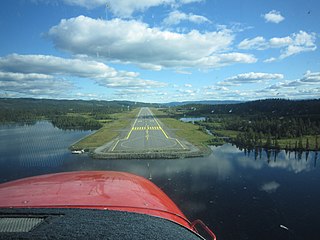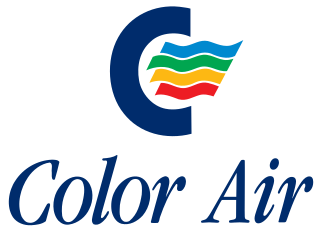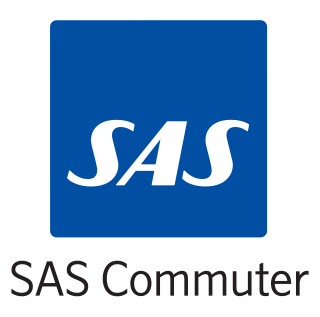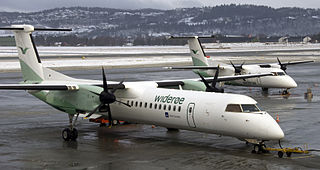Braathens ASA, until 1997 Braathens South American & Far East Airtransport A/S and trading as Braathens SAFE, was a Norwegian airline which operated from 1946 until it merged with Scandinavian Airlines (SAS) in 2004 to become SAS Braathens. For most of its history, Braathens was the largest domestic airline in Norway, but did not operate an international network for many years. Its main hubs were Oslo Airport, Fornebu and later Oslo Airport, Gardermoen, and briefly Stockholm-Arlanda Airport. The airline operated 118 aircraft of 15 models, mostly Boeing 737 variants. Braathens served 53 airports and 50 cities with scheduled services through its history.
Norwegian Air Shuttle ASA, trading as Norwegian, is a Norwegian low-cost airline and Scandinavia's second-largest airline, behind Scandinavian Airlines. It is the fourth largest low-cost carrier in Europe behind Wizz Air, easyJet and Ryanair, the largest airline in Norway, and the ninth-largest airline in Europe in terms of passenger numbers. It offers a high-frequency domestic flight schedule within Scandinavia and Finland, and to business destinations such as London, as well as to holiday destinations in the Mediterranean and the Canary Islands, transporting over 30 million people in 2016. The airline is known for its distinctive livery of white with a red nose, with portraits of high achievers on the tail fins of its aircraft.

Fagernes Airport, Leirin is a general aviation airport in Fagernes, in the municipality of Nord-Aurdal, Innlandet county, Norway. It has been an airport for passenger flights, serving Fagernes and the surrounding valleys of Valdres, Hallingdal and Gudbrandsdal in Southern Norway, 190 kilometres (120 mi) from Oslo. Opened in 1987, it was owned and operated by state-owned Avinor. The airport is located 822 metres (2,697 ft) above sea level, and has a 2,049-metre (6,722 ft) runway. It did provide a regional service for the local population to Oslo, subsidized by the Ministry of Transport, as well as charter services during winter serving the nearby ski resorts. In 2014, the airport had 6,393 passengers.

Coast Air AS was a regional airline based at Haugesund Airport, Karmøy in Norway. It was Norway's fourth largest airline and operated domestic services within Norway, in addition to international services. Routes were concentrated along the West Coast, as well as some public service obligation contracts in Southern Norway. The company had a fleet of de Havilland Canada Twin Otter aircraft, later replaced with Jetstream 31s and ATR 42s.

Busy Bee was an airline which operated in Norway between 1966 and 1992. Entirely based around wet lease, it conducted a mix of regional services for larger airlines and the military, as well as corporate, ad hoc and inclusive tour charters.

Kristiansand Airport is an international airport serving Kristiansand Municipality in Agder county, Norway. The airport is located in the district of Tveit in the Oddernes borough, about 16 kilometers (9.9 mi) by road and 8 kilometers (5.0 mi) by air from the center of town of Kristiansand. Operated by the state-owned Avinor, it is the sole airport in Southern Norway with scheduled flights. It has a 2,035-meter (6,677 ft) runway aligned 03/21 and served 1,061,130 passengers in 2018. Scheduled flights are provided by Scandinavian Airlines, Norwegian Air Shuttle, Widerøe, KLM Cityhopper and Wizz Air. The Royal Norwegian Air Force has a training center at the airport.
Linx AB was a railway company which operated inter-Scandinavian passenger trains between 2001 and 2004. Established as a joint venture between the Norwegian State Railways (NSB) and the Swedish state-owned SJ, Linx operated the routes from Oslo, Norway, to Stockholm, Sweden, and from Oslo via Gothenburg, Sweden, to Copenhagen, Denmark. Services were provided up to ten times per day. However, slow speeds caused by curvy infrastructure in Norway, combined with competition from low-cost airlines, caused the company to lose money, and eventually grounded operations. The services were taken over by NSB and SJ. The main rolling stock were eleven X2 electric multiple units, although it used SJ Rc-hauled trains on the Gothenburg–Oslo service. The company was based in Gothenburg.
Partnair A/S was a Norwegian charter airline which operated from 1971 to 1989. During the later 1980s it was Norway's fifth-largest airline by revenue, operating a fleet of three Convair CV-580 and six Beechcraft Super King Air. The airline was based at Oslo Airport, Fornebu, as well as operating a base at Stavanger Airport, Sola.

Båtsfjord Airport is a regional airport serving Båtsfjord in Troms og Finnmark, Norway. It consists of a 1,000 by 30 meters runway and served 14,485 passengers in 2016. A further 14,663 landed and started at the airport without leaving the aircraft. Scheduled services are provided by Widerøe using the Dash 8 to Kirkenes, Hammerfest and other communities in Finnmark. The airport is owned and operated by the state-owned Avinor.

Color Air AS was the first Norwegian low-cost airline. It operated from Oslo Airport, Gardermoen in 1998 and 1999 with a fleet of three Boeing 737-300 aircraft. Color Air was a brand extension of Color Line, which shared a common owner in the Olav Nils Sunde-controlled Color Group. The airline operated five daily round trips from Oslo to Trondheim and Bergen, four to Ålesund and one to London, in addition to a weekly trip to Alicante. Color Air pioneered the low-cost business model in Norway, with a denser seating, no frills and lack of a frequent flyer program. Tickets were sold only via the Internet, by telephone or in supermarkets; when bought from travel agents, there was a 200 kr surcharge.

SAS Commuter, also branded as Scandinavian Commuter, was a regional airline which operated in Denmark, Norway and Sweden. A sister company of Scandinavian Airlines (SAS), it operated various regional services on behalf of the Scandinavian flag carrier. The airline was headquartered at Copenhagen Airport, which also served as its main base. It later also operated bases at Tromsø Airport; Stockholm Arlanda Airport; Trondheim Airport, Værnes and Bergen Airport, Flesland.
Norway Airlines A/S was a Norwegian airline which operated between 1988 and 1992. Focusing on charter, the airline operated two Boeing 737-300 aircraft from 1988 to 1992, after which it operated two McDonnell Douglas MD-80 aircraft, one MD-83 and one MD-87. The airline flew a single scheduled route, between Oslo Airport, Fornebu and London Gatwick Airport, at first on contract with Air Europe and from 1991 at its own expense. At its peak, Norway Airlines had 196 employees. The company struggled financially and lost more than 100 million Norwegian krone (NOK) before terminating operations, having never made a profit.

Moss Airport, Rygge was a minor international airport serving Moss, Oslo and Eastern Norway. It is located in Rygge, 10 kilometres (6.2 mi) outside Moss and 60 kilometres (37 mi) outside Oslo. It also served as a regional airport for Østfold county and owned and was operated by the private company Rygge Sivile Lufthavn AS.

Hamar Airport, Stafsberg is a general aviation airport located at Stafsberg in Hamar, Norway. It features a 944-by-23-meter runway aligned 15–33 and is owned by Hamar Municipality. The airport is located in an area with very stable climate and good flying conditions.

Braathens SAFE's domestic market was deregulated on 1 April 1994. Since then, any airline within the European Economic Area is free to operate any domestic or international route. Braathens rejected a proposal from the main competitor Scandinavian Airlines System (SAS) for a merger; instead the helicopter division was sold and the company listed on the Oslo Stock Exchange. New routes were opened from Oslo Airport, Fornebu to Bodø, Harstad/Narvik and Tromsø, but the routes from Bergen to these cities were terminated. International routes to Rome, Nice and Jersey were introduced. In 1996, Braathens SAFE bought Sweden's second-largest airline, Transwede, and started flying on the Oslo–Stockholm route. The following year, Transwede, with its five domestic routes, was merged into Braathens SAFE. The same year, KLM bought 30% of Braathens SAFE and the airlines started a partnership.

Widerøe's Flyveselskap ASA, is a regional airline based in Bodø Norway, established by
Ansic AS, trading as FlyNonstop, was a virtual airline which operated out of Kristiansand Airport, Kjevik, Norway, in 2013. The airline had a 100-passenger Embraer 190 operated by Denim Air. FlyNonstop was owned by Espen Hennig-Olsen, and focused on full service on flights to primary airports serving the tourist market. The company slogan was Norwegian: Fra der du bor. Til dit du skal.
Båtsfjord Airport is a former regional airport located at Båtsfjorddalen in Båtsfjord, Norway. It consisted of an 800-by-30-meter gravel runway aligned 01–19 and had a simple terminal building. Construction of the airport was started a local aviation club in 1972 and was completed with a 600-meter (2,000 ft) runway in May 1973. The runway was extended the following year and in 1976 the airport was municipalized. From the start Norving operated air taxi and air ambulance flights. Following an upgraded terminal in 1978, the taxi services became scheduled and the Britten-Norman Islander was introduced to Kirkenes and Vadsø. From 1983 the Dornier 228 entered service on the Båtsfjord route.











